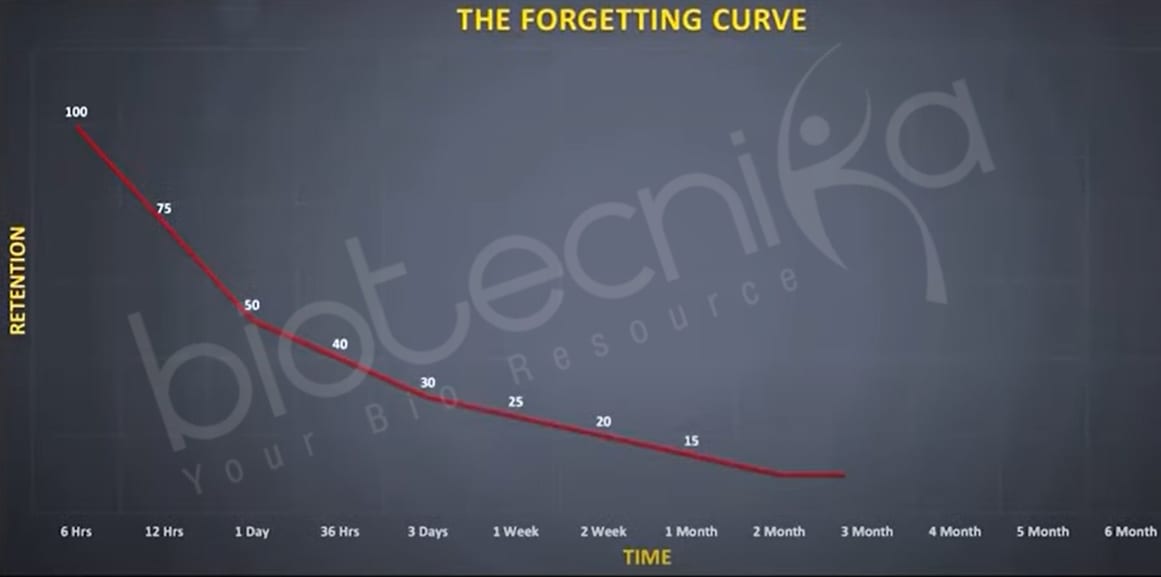How to Plan Revisions for Competitive Exams
Secrets Of Memory Decoded!
How to plan your revision for CSIR NET, GATE, DBT, ICMR, or other competitive exams?
What if our memory was like a pendrive? We could store something in it for once, then forget it, but it would stay there forever and we can access it anytime! How awesome that would have been right?
With a memory pendrive, there would have been no room for forgetting at all, thus no revisions needed! While it sounds exciting, unfortunately, we don’t actually have such a pendrive, at least we don’t have such technology yet.
Well, if you are someone who’s seriously rooting for this idea, then I’m guessing you are among the ones who have a hard time remembering and keeps forgetting things! Don’t worry, you have come to the right place!
Here in this article, BioTecNika is spilling the secrets of memory, the science of why we forget, and what we can do to remember longer! Learn the practical knowledge on how to plan revisions for competitive exams, the practical aspects, techniques of scheduling revisions in such a way that you remember the topics to the maximum amount, and avoid panicking
before the exam.All of us have been victims of our forgetfulness, especially forgetting occasions such as birthdays and marriage anniversaries, which would turn out to be really lethal, right? Sometimes we leave room to get something and we don’t remember why exactly we left the room, sometimes we forget to take our things, and so on. Generally, we have all forgotten things. So don’t we all wish we could remember things forever? I wish I could, but the thing is, memory erosion is real. Memory erosion is important for survival. But in case of CSIR, NET, GATE, ICMR, or DBT or any such exam, it can be lethal too, isn’t it?
To avoid this, let’s get on with some tips, tricks, techniques, and tools on How to Plan Revisions for Competitive Exams:
- Spaced Repetition: The first and most important one is called spaced repetition. What we have learned about memory from various researchers and scientists is that memories are encoded the strongest when we are paying attention. When you are deeply engaged in learning, that is when the memory is encoded into your mind for long. In the late 1880s, a German psychologist, Hermann Ebbinghaus spent eight years memorizing the random stuff, he randomly remembered stuff to research on how memory works. He plotted the rate at which his memory fades over time, showing the rate of Memory decay. This graph was called the forgetting curve.
Looking at the curve, we can notice that whenever you learn something new, the amount of information that you retain rapidly decreases over a period of time, and you are left with only half of the information within the first day. So actually, whatever you’re studying today, you forget it by the end of the day, isn’t it? Isn’t that brutal? Correct. But that’s actually how we maintain a memory. That’s how memory works. This is where Hermann’s second discovery comes in finding out how exactly we can fix this problem. He said that the downward slope of the forgetting curve can be flattened. The downward slope can be flattened by repeating or revising the information at regular intervals. Now, this is the principle which forms the foundation of learning methodology called spaced repetition.
But have you not been doing this forever? Yes, you have been revising, but, you’ve been doing it wrong. Here’s the right way to do it. First, you have to learn, then review and then re-review at regular intervals. This helps retain information longer. For instance, here’s a practical example. Suppose you do the first revision after one day, like today you study, and then tomorrow you revise or preferably revise on the same day also you can revise. Then you do the second revision within a week, the third revision within two weeks, and fourth revision after a month. And after that, you revise just before the exam or just a few days before the test.
You can also try another method, which we at BioTecNika call it a 1,2 1,2 technique:
- 1st Revision – After 1 day
- 2nd Revision – After 2 days
- 3rd Revision – After 1 week
- 4th Revision – After 2 weeks
- 5th Revision – After 1 month
- Last Revision – After 2 months
Your brain wants you to have a crisp memory, so it only remembers stuff that is important, and that it thinks is necessary. But, whenever we learn something new, the brain stores it in short term memory. The brain finds that we are not retrieving the information so often. Thus, when you don’t retrieve that information so often, the brain thinks that it’s of no use and it will dump it. However, if you keep revising at regular intervals, the brain will consider the information important and it will become a long term memory. For this, you have to have a schedule where you follow the right format of revision.
If you keep retrieving information at proper intervals, you can move information from the temporary memory into a long term memory. This is not something new right, it ain’t rocket science! We have been doing this forever since school right? But the key is to ideally space out the time between each revision, such that, you allow some amount of memory erosion, and this will help you make your memory stronger. It’s just like exercise. What do we do in exercise? Let’s assume that memory is a muscle. Just like exercise can make any other muscle in your body stronger, to make your memory strong, you need to work it out. You need to exercise it out. It will hurt a little, and then you have to allow some time to heal. Then repeat the exercise.
- Flowchart Technique: The second technique is called a flowchart technique. This technique is for faster revisions and better retention. For instance, let’s assume you are preparing for the CSIR NET exam and you are making notes. Make your learning interesting by making notes in the form of a flowchart or pictorial format and not in textual format. You can always buy BioTecNika’s Konceptika book, which also happens to be in a flowchart format. When you make flowcharts, they are basically pictures and your brain remembers pictures better. It is scientifically proven that the brain remembers pictures better. So when you open the notes, you are actually not really reading the text, but you are looking at an image and thus your revision can be faster and your brain will retain it better. This information will get retained better for a longer period of time.
- Flashcard Technique: The third technique is called a flashcard technique, where you can write a word on the card. It’s quite simple. Just take a card, write any keyword on the front and on the back of the card, write the description of what that keyword means. The flashcard helps you to remember better, on the go. It helps you revise faster, on the go. You can just carry the flashcard in your pocket and you can revise any moment. At BioTecNika, we also provide virtual + hardcopy flashcards that you can use for the same. This is one of the most simple methods of self-study that is widely used.
These techniques on how to plan revisions for competitive exams are among some of the smart techniques we at BioTecNika use to help our students become champions and ace the competitive exams! Incorporate these techniques in your revisions and watch your exam preparation drastically improve.


































